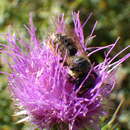Conservation Status
University of Alberta Museums tarafından sağlandı
No information indicating any concern.
- lisans
- cc-by-nc
- telif hakkı
- University of Alberta Museums
Cyclicity
University of Alberta Museums tarafından sağlandı
June to September. Nests constructed in July or August (Medler 1958).
- lisans
- cc-by-nc
- telif hakkı
- University of Alberta Museums
Distribution
University of Alberta Museums tarafından sağlandı
Nova Scotia and west to British Columbia, south to California, Utah, Colorado and Texas in the United States to North Mexico. (Krombein et al. 1970).
- lisans
- cc-by-nc
- telif hakkı
- University of Alberta Museums
General Description
University of Alberta Museums tarafından sağlandı
"Females: Body is15-20mm long, stout and completely black body. Soft downy hair (pubescence) is whitish and dense around antennae, sides of face, on top of head and on sides of thorax and thicker blackish hair on dorsal surface of the thorax. Large cheeks (width is twice the size of the eyes) to house muscles used for cutting leaves and mouth mandibles have 5 tooth projections (Mitchell 1962). Deep indentation on each side of the middle bulge of the clypeus (front of head below the antennae and frons and attached to the labrum mouthpart) (Medler & Lussenhop 1968). Wings are subhyaline (sub transparent) with brownish veins. Pollen collecting “scopa” on the ventral abdomen with dense hair and pale yellowish colour (Mitchell 1962).
Males: Body is 11-15 mm long, stout and completely black body. Pubescence is very dense and elongated around antennae, lower part of face, lower cheeks, posterior and sides of thorax. Pubescence elongate but less dense on dorsal surface of thorax. Large cheeks (width is twice the size of the eyes) and mouth mandibles have 3 tooth projections. Wings are subhyaline (sub transparent) with brownish veins. Robust and dense setae (bristle like-hair) on the sterna number 5 (ventral abdomen segments) and very dense setae on both sides of the midline of sterna number 6 and spine-like and elongated in the midline. Transverse apical lobe on sterna 6. Genital armatures have robust gonocoxites that are constricted medially and long setae on inner face. (Mitchell 1962)."
- lisans
- cc-by-nc
- telif hakkı
- University of Alberta Museums
Habitat
University of Alberta Museums tarafından sağlandı
Burrows into decaying poplar trees and constructs nest (Krombein et al. 1970, Medler 1958).
- lisans
- cc-by-nc
- telif hakkı
- University of Alberta Museums
Life Cycle
University of Alberta Museums tarafından sağlandı
Univoltine (one generation reaches maturity per year) (Fye 1965). Nests are constructed by the mother bee, using circular leaf pieces to create thimble-shaped cells, as well as using a combination of leaves, sawdust, moss, dirt, rotting wood and sand to construct protective plugs (Medler 1958). Once the nest is completed the orifice is covered using circular leaf pieces that are cemented together, sometimes incorporating sand and chewed leaves (Medler & Lussenhop 1968). The nests are smooth versus the rough appearance of M. relativa nests. Nests are similar to Mi>M. gemula except that the plug for M. gemula is comprised of leaf pieces (Fye 1965). This species is of little value in agricultural use for alfalfa pollination (Medler 1958).
- lisans
- cc-by-nc
- telif hakkı
- University of Alberta Museums
Trophic Strategy
University of Alberta Museums tarafından sağlandı
Polylectic (collects pollen from wide range of flowering plants). Pollen taken primarily from Compositae and Leguminosae flowers (Krombein et al. 1970) with flower records including Baptisia, Lathyrus, Rubus and Veronica (Mitchell 1962). Observations in Wisconsin show a preference for fireweed and thistles (Cirsium vulgare,C. altissimum, C. arvense) and infrequent use of alfalfa flowers (Medicago sativa) (Medler 1958).
- lisans
- cc-by-nc
- telif hakkı
- University of Alberta Museums
Megachile inermis
(
İngilizce
)
wikipedia EN tarafından sağlandı
Megachile inermis is a species of bee in the family Megachilidae.[1] It was described by Provancher in 1888.[1]
References

- lisans
- cc-by-sa-3.0
- telif hakkı
- Wikipedia authors and editors
Megachile inermis: Brief Summary
(
İngilizce
)
wikipedia EN tarafından sağlandı
Megachile inermis is a species of bee in the family Megachilidae. It was described by Provancher in 1888.
- lisans
- cc-by-sa-3.0
- telif hakkı
- Wikipedia authors and editors
Megachile inermis
(
Felemenkçe; Flemish
)
wikipedia NL tarafından sağlandı
Insecten Megachile inermis is een vliesvleugelig insect uit de familie Megachilidae. De wetenschappelijke naam van de soort is voor het eerst geldig gepubliceerd in 1888 door Provancher.[1]
Bronnen, noten en/of referenties Geplaatst op:
17-12-2011
Dit artikel is een beginnetje over biologie. U wordt uitgenodigd om op bewerken te klikken om uw kennis aan dit artikel toe te voegen.

- lisans
- cc-by-sa-3.0
- telif hakkı
- Wikipedia-auteurs en -editors
Megachile inermis
(
Vietnamca
)
wikipedia VI tarafından sağlandı
Megachile inermis là một loài Hymenoptera trong họ Megachilidae. Loài này được Provancher mô tả khoa học năm 1888.[1]
Hình ảnh
Chú thích
Tham khảo
- lisans
- cc-by-sa-3.0
- telif hakkı
- Wikipedia tác giả và biên tập viên
Megachile inermis: Brief Summary
(
Vietnamca
)
wikipedia VI tarafından sağlandı
Megachile inermis là một loài Hymenoptera trong họ Megachilidae. Loài này được Provancher mô tả khoa học năm 1888.
- lisans
- cc-by-sa-3.0
- telif hakkı
- Wikipedia tác giả và biên tập viên

